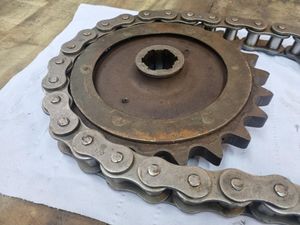Cracked brake drum and sourcing new tyres and chains are the latest challenges for Sunbeam 1,000hp restorers
National Motor Museum engineers piece together newly restored parts, while continuing the engine rebuild of Sunbeam 1,000hp which was made in Wolverhampton.

When Sir Henry Segrave was on his journey to America to make his record-breaking run in Sunbeam 1,000hp, news reached his team that fellow Land Speed Record breaker Parry-Thomas’ death in his latest attempt may have been caused by being hit by a broken chain.
Their answer was to protect Sir Henry with armour plating around the wheel arches, which would also contain any shredded rubber if tyres burst.
Unique tyres had been developed by Dunlop to withstand the record-breaking attempt of 200mph at Daytona on March 29 in 1927. Each tyre was only guaranteed for three-and-a-half minutes and both the wheels and tyres had to be changed after each run, using four handy jacks bolted to each corner of the car.

Sadly, no moulds for these tyres were kept and no tyres now exist – creating another challenge for the National Motor Museum engineers working on the Sunbeam restoration.

At some time in the landmark car’s history, before arriving at Beaulieu, its wheels had been modified to fit a 600 x 23 tyre size but even that size is now unavailable. So engineers have retained the only original part of the wheels – the hubs – while fitting new rims and spokes to replace the non-original, welded ones which had been added in the 1950s. They have kept to as close to the original wheel sizes as possible, with help to source new tyres from Vintage Tyres at Beaulieu.

Drive chains glowed red hot

Sunbeam’s designer Captain Jack Irving had already been concerned about running an immense amount of power through a conventional rear axle after drive chains glowed red hot during testing at the Wolverhampton works – which is why he created a unique three-speed gearbox to turn the rear wheels.
New replacement chains have also had to be sourced, as chains with the width size of the originals no longer exist.
Running Sunbeam into the surf
After Sunbeam was driven at speed into the surf to slow it down at Daytona, running red hot cast iron into the sea has taken its toll.
Specialist cleaning of the brake drums by LaserTec experts exposed a crack in one of the rear brake drums.
National Motor Museum Senior Engineer Ian Stanfield said: “We were hoping to repair the crack but it wouldn’t weld. It’s an expense we hadn’t wanted but we have needed to go to Bridport Foundry for a pattern to produce a new drum.”
Aluminium brake shoes also distorted and started to melt during the record-breaking run. At Daytona, the original engineering team replaced them with bronze and during the restoration, their oil-contaminated linings have been replaced.
Gleaming gearbox in museum
The gleaming, recently restored gearbox can be seen next to the newly Trimite-coated chassis and front engine by visitors to Beaulieu in the National Motor Museum.
Funds are needed to complete the full restoration project. Sunbeam 1000hp Restoration Campaign was launched with Hampshire-based Brookspeed Automotive and aims to raise £300k to complete the restoration of ‘The Slug’ with the ambition of taking it back to Daytona Beach in Florida for the centenary of its record-breaking run in 2027.
Donations for the Sunbeam 1000hp Restoration Campaign can be made online at nationalmotormuseum.org.uk/sunbeam-1000hp-restoration-campaign.
Sponsors and corporate donors who would like to be associated with the campaign are urged to get in touch by emailing nellie.rogers@beaulieu.co.uk.





